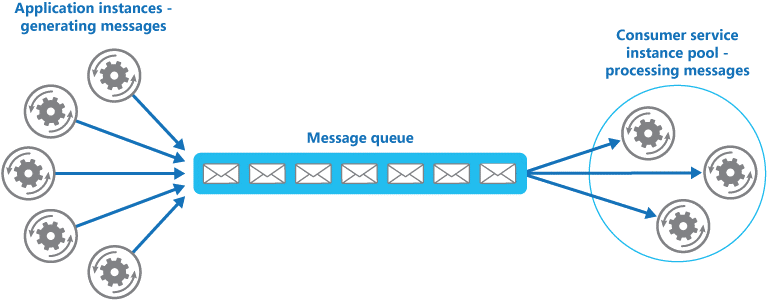Competing Consumers
RabbitMQ message broker
When to Use this Pattern
Use this pattern when:
- The workload for an application is divided into tasks that can run asynchronously.
- Tasks are independent and can run in parallel.
- The volume of work is highly variable, requiring a scalable solution.
- The solution must provide high availability, and must be resilient if the processing for a task fails.
This pattern may not be suitable when:
- It is not easy to separate the application workload into discrete tasks, or there is a high degree of dependence between tasks.
- Tasks must be performed synchronously, and the application logic must wait for a task to complete before continuing.
- Tasks must be performed in a specific sequence.
Context and Problem
An application running in the cloud may be expected to handle a large number of requests. Rather than process each request synchronously, a common technique is for the application to pass them through a messaging system to another service (a consumer service) that handles them asynchronously. This strategy helps to ensure that the business logic in the application is not blocked while the requests are being processed.
The number of requests could vary significantly over time for many reasons. A sudden burst in user activity or aggregated requests coming from multiple tenants may cause unpredictable workload. At peak hours a system might need to process many hundreds of requests per second, while at other times the number could be very small. Additionally, the nature of the work performed to handle these requests might be highly variable. Using a single instance of the consumer service might cause that instance to become flooded with requests or the messaging system may be overloaded by an influx of messages coming from the application. To handle this fluctuating workload, the system can run multiple instances of the consumer service. However these consumers must be coordinated to ensure that each message is only delivered to a single consumer. The workload also needs to be load balanced across consumers to prevent an instance from becoming a bottleneck.
Solution
Use a message queue to implement the communication channel between the application and the instances of the consumer service. The application posts requests in the form of messages to the queue, and the consumer service instances receive messages from the queue and process them. This approach enables the same pool of consumer service instances to handle messages from any instance of the application. Figure 1 illustrates this architecture.
Figure 1 - Using a message queue to distribute work to instances of a service
This solution offers the following benefits:
- It enables an inherently load-leveled system that can handle wide variations in the volume of requests sent by application instances. The queue acts as a buffer between the application instances and the consumer service instances, which can help to minimize the impact on availability and responsiveness for both the application and the service instances (as described by the Queue-based Load Leveling pattern). Handling a message that requires some long-running processing to be performed does not prevent other messages from being handled concurrently by other instances of the consumer service.
- It improves reliability. If a producer communicates directly with a consumer instead of using this pattern, but does not monitor the consumer, there is a high probability that messages could be lost or fail to be processed if the consumer fails. In this pattern messages are not sent to a specific service instance, a failed service instance will not block a producer, and messages can be processed by any working service instance.
- It does not require complex coordination between the consumers, or between the producer and the consumer instances. The message queue ensures that each message is delivered at least once.
- It is scalable. The system can dynamically increase or decrease the number of instances of the consumer service as the volume of messages fluctuates.
- It can improve resiliency if the message queue provides transactional read operations. If a consumer service instance reads and processes the message as part of a transactional operation, and if this consumer service instance subsequently fails, this pattern can ensure that the message will be returned to the queue to be picked up and handled by another instance of the consumer service.

